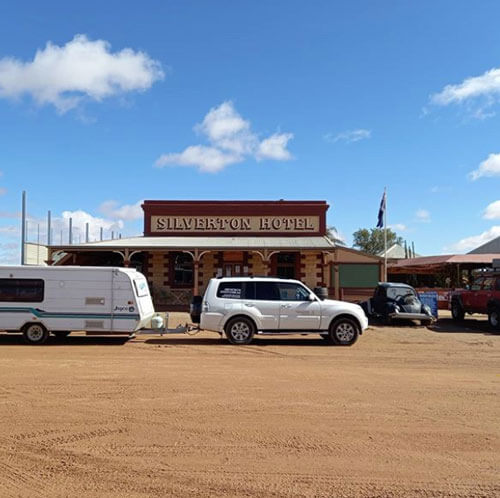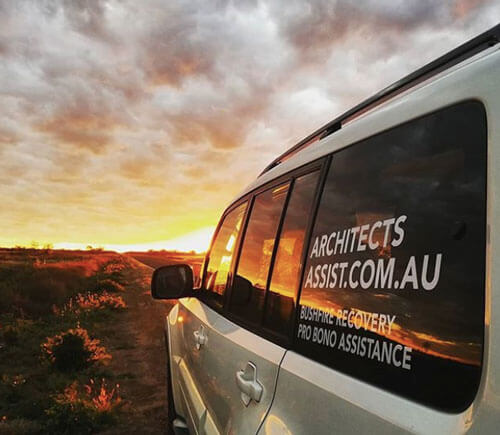Written by Jiri Lev, edited by the Australian Institute of Architects
Jiri Lev is an Australian building and urban designer. He has been working with the Australian Institute of Architects on the Architects Assist program, a network set up for architects who wish to help affected Australians rebuild after the devastating summer bushfires. In this piece, Jiri details his recent visit to some of these communities in need.
On 24 July my wife and I departed from our newly adopted home in Tasmania on our tour across the bushfire-affected regions, raising awareness of the Architects Assist services along the way. Our aim is to give advice, document the devastating consequences of the fires in these communities and make referrals to the generous contributors in the Architects Assist network.
From Blue Mountains to Northern Rivers
Our first report covered our tour from the Spirit of Tasmania Ferry to the Blue Mountains. In the Greater Sydney, Mid-Western and Hunter regions, we felt relieved to see most of the places we used to live in before our move to Tasmania were spared from the fires. Unlike further North in Manning, where 150 houses were lost.
A gentleman took us to a site surrounded by a freeway and roads, considered low risk prior to the last fire. A massive fireball had descended on his home moments after the heat forced him to come down from its roof which he was watering. Only a bare concrete slab now indicates the size and location of his former brick veneer home.
Over the past few months the owner had been fighting post-traumatic stress from the event. It is important to note that a light-hearted, direct approach, however well meant, is not the most appropriate attitude in discussions with disaster victims. The experience of losing a house in a fire, particularly if one was present trying to protect it, leaves deep scars on human spirit, not unlike being involved in a tragic car accident.
I have found that the key to communication with a disaster victim is listening, compassion, more listening, clarification and possible solution, probably in that order.
On many burnt sites, we observed thin corrugated metal sheets twisted or curled up after they peeled off buildings in intense heat, unlike traditional thicker galvanised steel.
We heard about plastic gutters, downpipes, even garden tools self-igniting in radiant heat, sometimes in the immediate vicinity of the homeowner, fighting the oncoming blaze. This may be due to accelerated off-gassing. Diligent hazard reduction and roof sprinklers appear to be among the most effective bushfire protection measures. We visited several homes that had utilised one or both of these, still standing and practically unharmed, while nearby houses and equipment were reduced to dust piles.
In many small villages like Bobin, families still live in donated tents, pods or caravans. These communities have been invariably pleased to learn about Architects Assist and will be reaching out to architects.

In Nambucca, 65 homes were lost. In Walcha and other regions, many of the homes that were lost were in extremely isolated and inaccessible sites, often several hours on a 4WD track away. Local government officers have begun moderating the initial contact between Architects Assist architects and clients such as these, as well as those with limited internet literacy.
A number of government grants available for rebuilding individual and community assets depend on prior development approval, which can be prohibitive. This represents one of the many opportunities for our architects to assist, by providing the initial concept and planning advice pro bono, with the possibility of covering some of their costs later, after the grant funding for the project has been secured.
At Wytaliba, the last house site was cleared from debris only the week before we arrived. Here two lives and 66 homes were lost. With very short warning of the approaching firestorm, many locals sought shelter at their cricket pitch during the fire. They survived in their cars by moving about the field away from flames as the blaze was passing. We are now in discussions with the community representatives about the design and construction of a multi-purpose community refuge shelter there, possibly involving architecture student volunteers.

ONWARD
With the East coast part of our tour complete and Queensland borders recently closed, our next stop is in South Australia, after a forced two week break in the “Red Centre” to comply with border restrictions. Here I am able to catch up with my projects, sit my Architectural Practice exam and spend time with my amazing wife Aleksandra without whom the tour simply would not be possible, and our baby son.
We continue being approached by people that are confused about the role and capacity of architects. Many are surprised that architects can design buildings to resist bushfires. Architects Assist has also been receiving enquiries from clients and government representatives related to our earlier stops, proving that our tour and engagement with these communities has been effective.
It’s been a blessing and a great pleasure to have the opportunity to speak for design professionals and to see some positive change.
